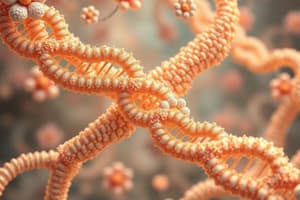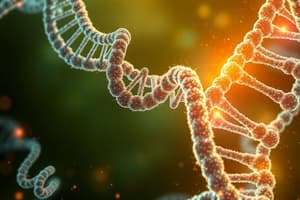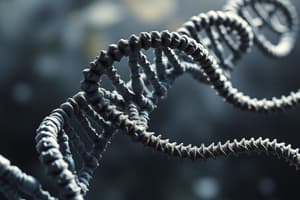Podcast
Questions and Answers
What is the function of a gene?
What is the function of a gene?
What process is responsible for copying a DNA sequence into a messenger RNA sequence?
What process is responsible for copying a DNA sequence into a messenger RNA sequence?
How many base pairs are typically found in a single gene?
How many base pairs are typically found in a single gene?
What is the main difference between the sugar molecules found in DNA and RNA?
What is the main difference between the sugar molecules found in DNA and RNA?
Signup and view all the answers
Which of the following is NOT a difference between DNA and RNA?
Which of the following is NOT a difference between DNA and RNA?
Signup and view all the answers
Why is it important for mRNA to be able to leave the nucleus?
Why is it important for mRNA to be able to leave the nucleus?
Signup and view all the answers
What is the difference between transcription and translation?
What is the difference between transcription and translation?
Signup and view all the answers
Which base is found in RNA but NOT in DNA?
Which base is found in RNA but NOT in DNA?
Signup and view all the answers
Study Notes
Protein Synthesis Overview
- Protein synthesis is the process cells use to make proteins from DNA.
- It involves two main steps: transcription and translation.
Gene Structure
- A gene is a section of DNA.
- Genes contain instructions for making specific proteins.
- Genes vary in length, ranging from hundreds to thousands of base pairs.
- Each chromosome contains thousands of genes.
- The average gene has approximately 13,000 base pairs.
Transcription
- Transcription is the process of creating mRNA from DNA.
- This step takes place in the nucleus.
- A special copy of DNA (mRNA) is created to carry instructions to the ribosomes.
- mRNA is a single-stranded molecule, unlike the double-stranded DNA.
- mRNA contains different bases than DNA. The base thymine (T) in DNA is replaced by uracil (U) in mRNA.
- The process uses an enzyme called RNA polymerase.
mRNA and DNA Differences
- DNA has deoxyribose sugar, while mRNA has ribose sugar.
- DNA is double-stranded; mRNA is single-stranded.
- DNA bases are A, T, C, and G; mRNA bases are A, U, C, and G.
- DNA stays in the nucleus; mRNA moves out of the nucleus to the cytoplasm.
Translation
- Translation is the second step in protein synthesis.
- It happens outside the nucleus in the cytoplasm.
- Ribosomes read the mRNA code.
- The code determines the sequence of amino acids.
- Amino acids are linked together to make a protein.
DNA's Role in Protein Synthesis
- DNA contains the instructions for making proteins.
- DNA stays in the cell nucleus.
- It cannot leave and provide the instructions directly to the ribosomes in the cytoplasm.
- mRNA is produced during transcription to carry the instructions from DNA to the ribosomes.
Problem of DNA Location
- DNA resides in the cell nucleus.
- Ribosomes, which synthesize proteins, are located in the cytoplasm.
- A messenger molecule (mRNA) is needed to carry the DNA instructions to the ribosomes.
Summary
- Genes on DNA contain instructions for making proteins.
- Transcription produces mRNA copies of genes in the nucleus.
- mRNA carries the code to ribosomes in the cytoplasm, where translation occurs.
- Proteins are produced by linking amino acids together based on the mRNA code. This process results in different traits.
Studying That Suits You
Use AI to generate personalized quizzes and flashcards to suit your learning preferences.
Related Documents
Description
Explore the fundamentals of protein synthesis, including the roles of genes, transcription, and translation. This quiz will test your understanding of how cells create proteins from DNA and the differences between mRNA and DNA. Delve into the intricate processes that ensure proteins are synthesized correctly within the cell.




